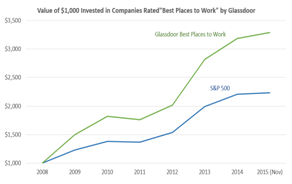... Good decisions depend on good measurement.
Ben Bernanke
Measure and Manage:Why?
The term assessment sometimes gets a bad rap. Maybe it's because of those standardized tests we had to take in school or being measured on something that didn't really fit the job to be done. Yet any time you make a choice - be it a new car or a donut, you are assessing, with all the information you have at hand, the relative value to you.
For your company the power of assessment is two-fold. First of all, getting a snapshot of the status of things gives action-oriented managers information they can use to manage, maintain and adapt toward higher performance. Without it, you’re flying blind.
The second benefit of purposeful measurement is to let your employees be accountable. It lets them see how they're doing, which leads to more job satisfaction and better performance. People who are part of an organization they speak of with pride deliver their best work. “Best Places to Work” data shows the results.
Just show me the numbers: Good news, bad news
Some managers just want to know if the numbers are “okay.” If they are, “no worries.” Unfortunately, "good news" financial results are a look in the rear-view mirror. They are a lagging_measure of reality. Getting the outstanding financial results demonstrated by the green trace [above] was made possible by consistent attention executives focused on leading performance indicators such as communication, culture, and engagement.

Courtesy of Dr. L. Bassi
Truebridge Partners Portfolio of Assessments: We help you measure what matters.
We offer standard, 360, normalized, and custom designed options. And we also offer unique scorecards to collect data in five key areas: Communication, Culture, Engagement, Innovation, and Team Performance.
Our proprietary instruments are designed to minimize the burden on participants. For example our Engagement Scorecard [E4] asks users four questions each about the work experience in four areas:
energy, involvement, effectiveness, support. They are easy to answer, e.g., I feel my work energizes me.
ROA - Return on Assessment.
Here's how assessments have paid off for some of our clients
Early Warning – Micro-case: At the request of the COO we ran a Performance Scorecard [T4] with a high tech team. Financial performance was good. Performance Scorecard results were positive in every category - except two. One; team members had been consistently missing deadlines, and two; their morale was poor. A conversation with the leader revealed that nearly all team members where high performing PhDs, recruited from the nation’s best STEM programs including Harvard, MIT, and Stanford. These were not people used to failure. Red flag: regularly missed deadlines are failure.
On the contrary, these people were used to success in the lab, in life, in business. Consistently missing their deadlines was bringing down morale. Loss of even one team member would have set the work back at least six months and perhaps a year, according to the leader. By that point the financials would indicate serious problems. The good news was that seeing the leading indicator data, enabled the leader to make a successful course correction. The business continued to thrive.
Culture – Micro-case: One CEO was concerned about workplace culture in his young rapidly growing organization. We recommended a widely used tool with a large user base. The data indicated he had reason to be concerned. The culture assessment revealed his knowledge-based business had two distinct leadership cultures. One was relatively high functioning, the other was not. We were also able to show industry specific normative data that enabled him to see how his firm compared to others. Further, the data also revealed actionable opportunities that enabled executives to begin the work of shaping a single positive sustainable culture.
Increased EBITDA – Micro-case: After a take-over and reduction in force at this firm of about 1,200 people, we were asked to run an engagement assessment on the survivors. Given the circumstances, , we suggested using the T4 MAP process instead. The T4 MAP combines an assessment and a process that enable employees to become more deeply engaged. Five different teams participated resulting in an estimated annual improvement in excess of $2 million (EBITDA). Full results were published in Performance Improvement Quarterly, January 2015. [1] The work also received the Award of Excellence from the International Society for Performance Improvement.
What do you want to measure?
Truebridge helps to develop a clear understanding of what you want to know. You may use any of Truebridge Partners’ proprietary instruments without charge. After you view your results you can get our input about actions we’d recommend in order to get the results you want. It may be easier than you think to create a “Good Company” to work for environment. The fact is, when leaders invest in their people in a thoughtful and disciplined way, that investment is repaid many times over.
